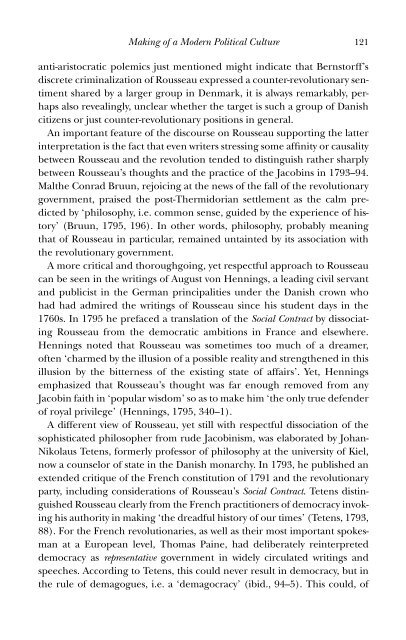Rousseau and Revolution
Rousseau and Revolution
Rousseau and Revolution
Create successful ePaper yourself
Turn your PDF publications into a flip-book with our unique Google optimized e-Paper software.
<strong>Rousseau</strong> <strong>and</strong> the Terror 57<br />
Finally, pointing away from the judgement that <strong>Rousseau</strong> was a decisive<br />
resource for the Terror is the fact that revolutionaries became increasingly<br />
comfortable dismissing him. In October 1793, a speaker at the Convention<br />
denounced the burning of suspect books by noting that <strong>Rousseau</strong> himself<br />
had dedicated one of his works to the Prince of Orange. In November, the<br />
Convention rejected the idea that <strong>Rousseau</strong>’s image be affi xed to a new<br />
pendule décimale, opting instead for the martyr Jean-Paul Marat. In January<br />
1794, someone proposed that the widow of Challier – Jacobin martyr in<br />
Lyon – be given the same pension as <strong>Rousseau</strong>’s widow since Challier had<br />
actually done more for the revolution than Jean-Jacques. 8<br />
By Thermidor, it became easier to criticize <strong>Rousseau</strong>. The fact is ironic<br />
given the transfer of <strong>Rousseau</strong>’s remains to the Pantheon in October 1794.<br />
For instance, that month, the Abbé Gregoire could both cite <strong>Rousseau</strong> as<br />
an authority <strong>and</strong> then note that while he had said some useful things on<br />
science, his views on the inevitable failure of large republics <strong>and</strong> how representation<br />
diminishes a people’s freedom – these were questionable. One<br />
last <strong>and</strong> poignant example will suffi ce to make the point. In September<br />
1794, <strong>Rousseau</strong>’s widow, Thérèse Levasseur, arrived at the Convention with<br />
two manuscripts the philosopher had given her with instructions delivered<br />
on this deathbed that they remain sealed until 1801. In the subsequent<br />
debate, Barère made the provocative claim that the revolution had in fact<br />
speeded up time; thus, there was no need to wait until the new century.<br />
Others disagreed. But then Jacques-Alexis Thuriot spoke, suggesting that<br />
the manuscripts be sent to the Committee on Public Instruction to determine<br />
their value or ‘danger’. He concluded his proposal that the package<br />
be opened by arguing that ‘the particular will must cede to the general<br />
will’. The irony could not have been lost on those assembled. The manuscripts<br />
were soon read <strong>and</strong> discussed publicly. <strong>Rousseau</strong> the author had<br />
been surpassed by the revolution he had helped set in motion. 9<br />
Geneva, festive celebration, aesthetic production, iconic authority – the<br />
picture that emerges of <strong>Rousseau</strong> in 1793 <strong>and</strong> 1794 had immediately very<br />
little to do with the violence associated with the Terror. With respect to the<br />
version of the Terror briefl y introduced above – as over-determined chaos<br />
in a democratic void – these str<strong>and</strong>s of revolutionary <strong>Rousseau</strong>ism can be<br />
treated as rather minor or occasional elements. There are obviously exceptions<br />
– in April 1794 Saint-Just called <strong>Rousseau</strong> a revolutionary – <strong>and</strong> there<br />
is no doubt that generally speaking <strong>Rousseau</strong> was an intellectual resource for<br />
the dilemmas <strong>and</strong> tensions of revolutionary culture. 10 And yet, there is not a<br />
great deal of evidence that the revolutionaries themselves placed <strong>Rousseau</strong> at<br />
the conceptual center of the Terror’s political violence. Robespierre at times<br />
mentioned <strong>Rousseau</strong> before he joined the Committee of Public Safety in
















